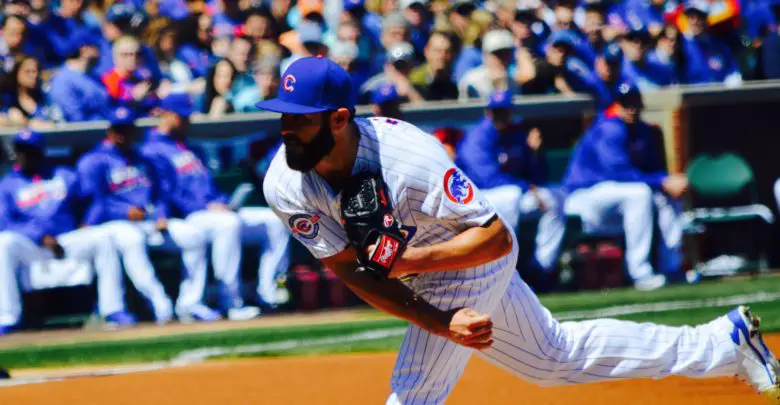
Recent Numbers Be Damned, Signing Jake Arrieta Makes Sense for Cubs
Elevated Sinkers Could Key Resurgence
Jake Arrieta is back in Chicago and I can barely hold it together enough to type right now. This makes so much sense for both the Cubs and Arrieta. Listen, his numbers were not impressive with the Phillies. I get that. I also don’t really care. I care more about how Arrieta went about pitching during his time in Philadelphia, because that’s what we need to consider.
Arrieta turned into a contact-first pitcher over the last three years, a decided change from his tenure as a Cub. During his prime 2015-2016 seasons, the former Cy Young winner whiffed batters at a 24% rate. But with the Phillies, he only whiffed batters at a 17% clip. So what happened?
Part of it is velocity, as Arrieta is throwing about 1 mph slower in his older age, but I don’t think that tells the whole story. A bigger culprit might be that Arrieta’s repertoire is stuck in the past when baseball was a completely different game. The game now features more swings built to generate launch angle against low pitches, which has been terrible for Arrieta’s heavy-sinker repertoire.
But do you know who has adapted to the launch angle revolution? The Cubs’ new pitching development team headed by Craig Breslow and implemented by pitching coach Tommy Hottovy.
The Cubs have encouraged their pitchers to elevate sinkers, a trend best visualized by the distribution graph below. What you will notice is that Kyle Hendricks (red) throws more high sinkers (further to the right on the figure) than Arrieta (blue) and MLB pitchers as a whole (grey). You’ll also notice that Arrieta tends to throw more sinkers lower in the zone than his counterparts.

Boom! That’s it, right? It’s just as simple as telling him to throw higher sinkers, right? Well, there’s probably more room for tweaking here, so let’s ask the computer to find those intervention targets.
Using machine learning, my computer can predict whether Arrieta will induce a swinging strike on a sinker with 97% accuracy. My computer specifically said that horizontal movement, vertical movement, and plate location are the most important. What wasn’t important included release point, previous pitch, previous two pitches, and the location of the previous pitches.

This suggests that variance in Arrieta’s 2020 sinker location and movement could be an intervention target. Specifically — if we just ignore the figure above — throwing sinkers inside with more tailing action leads to more whiffs. Of course, all of this should only be adjusted if the consequences don’t appear counterproductive, which can only be discerned through open communication and live performances.
The other aspect here is that Arrieta may have been a little resistant to change and he won’t necessarily be bowled over by tweaking his approach based on what the metrics indicate.
“There was a weird transition there for like three or four years,” Arrieta said in 2020. “As smart as a lot of these analytical teams are…Taking guys that throw sinkers and transitioning them to a guy that throws four-seamers up. It’s happened all around baseball and it’s foolish.
“The message has been sent that we’re all going to be good at down and away. It’s the hardest pitch to hit in the game and it always will be. I don’t care what new guru comes along and tries to say that the evidence shows the cutter is the only pitch you throw. I’m not going to listen or believe any of it. Down and away is and will always be good.”
Perhaps the key here is that the Cubs don’t tell their pitchers to scrap their sinkers in favor four-seams, they do the opposite. They’ve told their pitchers to throw more sinkers higher in the zone. Hendricks, Alec Mills, José Quintana, Tyson Miller, and Brailyn Márquez all either developed a sinker or threw more elevated sinkers in the 2020 season.
Perhaps Arrieta understands his new coaches won’t ask him to scrap his sinker but will instead show him how to optimize the low-and-away pitch. According to the above analysis, he likely would induce more whiffs. And if starts throwing more elevated sinkers, there is a good chance he’ll induce even more whiffs, based on what we observed with 2020 Cubs pitchers. That means he’s going to prevent more runs, which means he is going to get more standing ovations from whatever percentage of fans are allowed to attend.
Numbers aside, Arrieta is also healthy now after undergoing elbow surgery late in 2019 and recovering from a hamstring injury late in 2020. His fanatical workout regimen is well documented, so he should continue to age relatively well in that regard.
Forgetting everything else for a moment, how cool is it that one of the Cubs’ most legendary pitchers is back with the team? Even if you aren’t enthused by the signing, which a lot of people aren’t based on recent performance, I hope you can at least find it in your heart to dwell on the nostalgia aspect.
I’ve written countless posts about Arrieta because I simply love watching the man pitch and I’m beyond excited to write about him again as he starts a new chapter with the Cubs.

